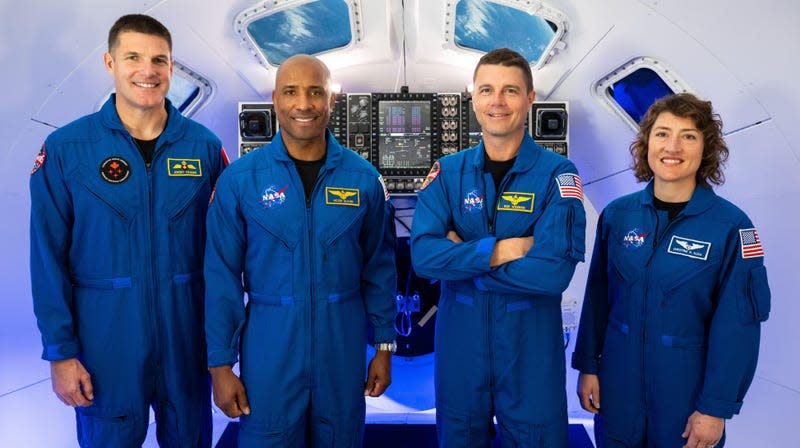NASA Astronauts Set to Take the Wheel of Lunar Spacecraft for Artemis 2 Test

The Artemis 2 astronauts are gearing up for a key test of the Orion capsule, to see if the Moon crew can manage manual maneuvers prior to a lunar flyby.
NASA’s Artemis 2 mission is set to launch in September 2025, carrying a four-person crew on board the Orion capsule for the first time on a 10-day journey to the Moon and back. Although most of the spacecraft’s maneuvers are automated, about three hours into the flight, the astronauts will have to take the wheel to command Orion through a series of moves, according to NASA.
To prepare for this manual mode, the crew is set to participate in a ground demothat will last for a little over an hour. “There are always differences between a ground simulation and what an actual spacecraft will fly like in space,” Brian Anderson, Orion rendezvous, proximity operations, and docking manager within the Orion Program, said in a statement. “The demonstration is a flight test objective that helps us reduce risk for future missions that involve rendezvous and docking with other spacecraft.”
Although the Artemis 2 crew will not land on the lunar surface, the astronauts will travel to the far side of the Moon at a distance of about 230,000 miles (370,150 kilometers) away from Earth. The Artemis 2 crew consists of NASA astronauts Christina Koch, Victor Glover, and Reid Wiseman, and Canadian Space Agency astronaut Jeremy Hansen.
The Orion capsule will launch aboard the Space Launch System (SLS) rocket, automatically separating from the rocket and firing several separation bolts. Once the capsule is a safe distance away from the launch vehicle, Orion will perform an automated backflip to turn around and face the upper stage, known as the interim cryogenic propulsion stage (ICPS).
When it’s at a distance of 300 feet (90 meters), the crew will take over the Orion capsule to pilot within 30 feet (9 meters) using translational hand controllers (for moving the spacecraft in various directions) and rotational hand controllers (for adjusting orientation). “The crew will view the target by using a docking camera mounted inside the docking hatch window on the top of the crew module to see how well aligned they are with the docking target mounted to the IPS,” Anderson said.
At that point, the Artemis astronauts will then perform small maneuvers to see how the spacecraft’s fine handling performs in close proximity to another spacecraft. Once that’s done, the Orion spacecraft will back away to allow the rocket stage to turn so that it can protect its heat-resistance-related components, and then the crew will follow the stage to perform another set of tests before backing away.
The rocket stage will then fall back towards Earth’s atmosphere while Orion begins its journey towards the Moon. “As with many of our tests, it’s possible the proximity operations demonstration won’t go exactly as expected,” Anderson said. “Even if we don’t accomplish every part of the demonstration, we’ll continue on with the test flight as planned to accomplish our primary objectives, including evaluating Orion’s systems with crew aboard in the deep space environment and keeping the crew safe during the mission.”
Earlier this year, NASA announced that it was delaying its Artemis timelineto address safety and technical issues related to the spacecraft. The Artemis 2 mission was originally scheduled for November 2024 (now moved to September 2025) and the follow-up Artemis 3 mission, which was originally scheduled for late 2025, was delayed to September 2026.
NASA is still working to resolve an issue with the Orion capsule’s heat shield, which is designed to protect the astronauts from extreme temperatures during a fiery reentry through Earth’s atmosphere. The space agency has made it clear that it will not launch Artemis 2 unless it figures out why the heat shield suffered more damage than it was supposed to during the Artemis 1 mission.
The Artemis team had also discovered issues with the valves in the Orion capsule’s life support system that’s designed to keep the crew alive inside the spacecraft. The valves passed the test for Artemis 2, but failed during testing for the Artemis 3 mission due to a design flaw. NASA engineers also noted deficiencies in the performance of Orion’s batteries, which are designed to be used in case of emergency should the spacecraft need to separate from the rocket.
The crew of astronauts is still preparing for the upcoming trip, learning how to operate the spacecraft manually for its orbital demonstration.
Want to know more about humanity’s next giant leap in space? Check out our full coverage of NASA’s Artemis Moon program, the new Space Launch System (SLS) rocket and Orion spacecraft, the recently concluded Artemis 1 mission around the Moon, the four-person Artemis 2 crew, NASA and Axiom’s Artemis Moon suit, and the upcoming lunar Gateway space station. And for more spaceflight in your life, follow us on Twitter and bookmark Gizmodo’s dedicated Spaceflight page.

